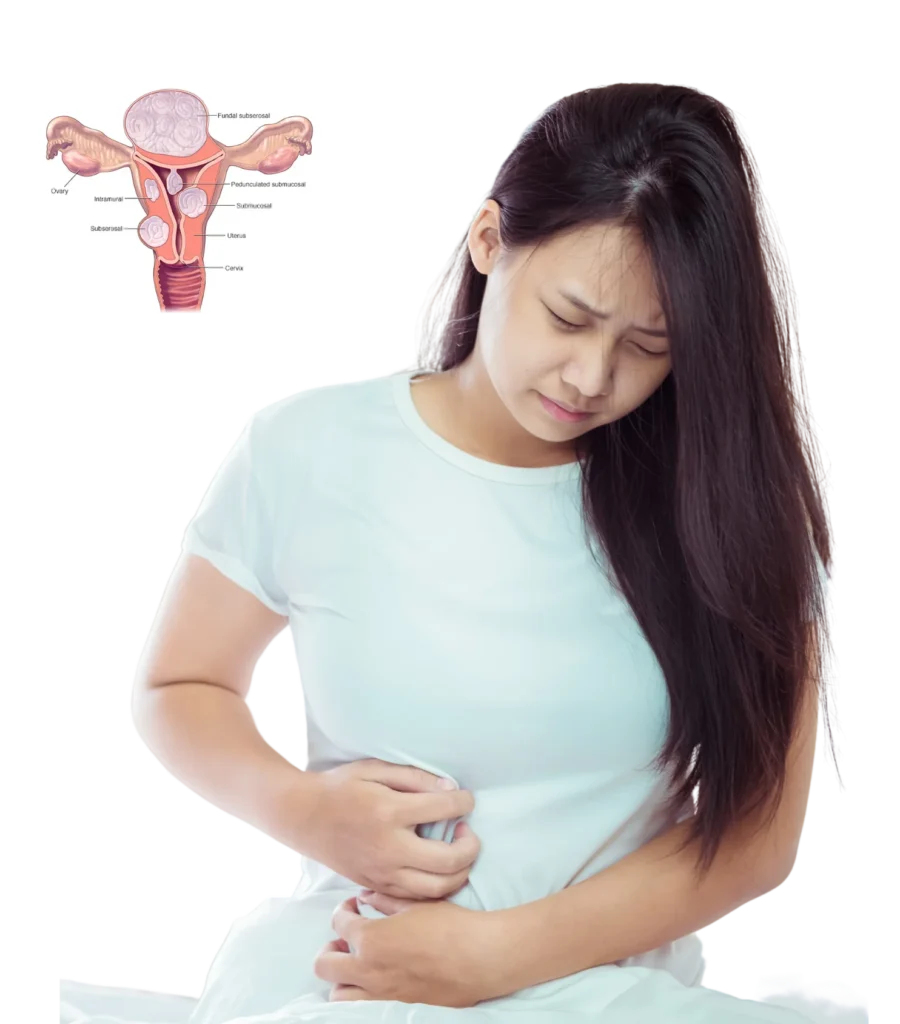
Uterine Fibroids Treatment in Hyderabad: Expert Care at Lux Hospitals Introduction
Small growths in the uterus called uterine fibroids can lead to pain, discomfort, heavy bleeding, and even problems with conception. Women with uterine fibroids can receive sophisticated, individualized care at Lux Hospitals, where we specialize in uterine fibroids treatment in Hyderabad. Whether you need laser therapy, medical management, or surgical options, our experienced gynecologists are here to help you reclaim your health and comfort.
What are Uterine Fibroids?
Uterine fibroids are tumors of the uterus’ smooth muscles that can vary in size from tiny seedlings to bulky masses. While many women have no symptoms, others may experience heavy menstrual bleeding, pelvic pain, frequent urination, and reproductive complications.
In simple terms, fibroids are growths that form in or on the uterus. Depending on their size, location, and number, they can range from harmless to problematic.
Causes of Uterine Fibroids
Although the exact cause isn’t clear, several factors may contribute to their development:
- Hormonal changes (especially estrogen and progesterone)
- Genetic predisposition
- Obesity
- Early onset of menstruation
- Vitamin D deficiency
- Lifestyle and diet factors
Understanding the Causes of uterine fibroids helps in early detection and planning the best course of treatment.
Common Symptoms of Uterine Fibroids
- Heavy or prolonged menstrual bleeding
- Pelvic pain or pressure
- Frequent urination or difficulty emptying the bladder
- Constipation
- Pain during intercourse
- Backache or leg pain
- Difficulty getting pregnant
If you’re experiencing these symptoms, it’s essential to seek Uterine fibroids Treatment in Hyderabad from trusted professionals at Lux Hospitals.
Diagnosis of Uterine Fibroids
At Lux Hospitals, we use advanced diagnostics including:
- Pelvic examination
- Ultrasound
- MRI
- Hysteroscopy
These tests help us determine the fibroids’ type, size, and location, guiding our approach to the best Uterine fibroids Treatment in Hyderabad.
Best Treatment options for Uterine Fibroids
We provide a variety of remedies based on the symptoms of each patient.
Medication-Based Management
For women with mild symptoms or small fibroids, medication can help manage symptoms and shrink fibroids to an extent.
- Hormonal Therapy: Birth control pills, GnRH agonists, and hormonal IUDs help regulate heavy bleeding and pelvic pain.
- NSAIDs: Nonsteroidal anti-inflammatory drugs reduce pain but don’t affect fibroid size.
- Iron Supplements: To treat anemia caused by excessive uterine fibroid bleeding.
This is often the first line of uterine fibroids treatment before considering procedures.
Minimally Invasive Laser Treatment for Uterine Fibroids
Lux Hospitals specializes in laser treatment for uterine fibroids, a modern, non-invasive option that offers precision, faster recovery, and minimal discomfort.
- Laser Ablation: The uterus is preserved while fibroid tissue is destroyed using a small laser probes.
- Ideal for: Women with moderate symptoms and who prefer non-surgical treatment for uterine fibroids in India.
- No large incisions
- Short hospital stay
- Minimal blood loss
- Quicker return to daily activities
Uterine Fibroid Embolization (UFE)
Uterine fibroids can be treated non-surgically with UFE. By stopping the fibroids’ blood flow, it causes them to shrink.
- Performed by our skilled interventional radiologists.
- It preserves the uterus and may maintain fertility.
- Suitable for women who do not want surgery but need relief from uterine fibroid bleeding and pressure symptoms.
Myomectomy (Fibroid Removal Surgery)
Myomectomy is a uterine fibroids treatment surgery aimed at removing fibroids while keeping the uterus intact—ideal for women planning future pregnancies.
- Laparoscopic Myomectomy: Minimally invasive, quicker recovery.
- Hysteroscopic Myomectomy: With regard to uterine fibroids.
- Abdominal Myomectomy: For large or multiple fibroids.
This is often the best treatment for uterine fibroids when fertility preservation is a priority.
Hysterectomy (Complete Uterus Removal)
In cases where fibroids are large, multiple, or cause severe symptoms and the woman does not plan future pregnancies, hysterectomy may be recommended.
- Total (uterus and cervix)
- Subtotal (uterus only)
- Laparoscopic or robotic-assisted
Though more invasive, it offers a permanent solution to fibroids and related symptoms.
Uterine Fibroids Diet Treatment (Supportive Care)
While diet alone cannot eliminate fibroids, specific dietary adjustments can help manage symptoms:
- Increase intake of anti-inflammatory foods (berries, leafy greens)
- Reduce red meat and processed foods.
- Focus on iron-rich foods if dealing with fibroid bleeding.
- Limit caffeine and alcohol.
This approach supports medical or surgical treatments and helps prevent recurrence of uterine fibroids.
Risks of Uterine Fibroids
Untreated uterine fibroids can lead to the following complications:
- severe blood loss-related anemia
- Infertility or pregnancy-related issues
- infections of the urinary tract
- persistent pelvic discomfort
- Being aware of the dangers of uterine fibroids is essential to acting quickly to improve one’s health.
Prevention of Uterine Fibroids
Though not all fibroids are preventable, you can reduce your risk with these tips:
- Maintain a healthy weight
- Eat a balanced diet
- Get regular exercise
- Manage stress
- Regular gynecological check-ups
Focusing on preventing uterine fibroids can reduce the severity and need for invasive treatment.

Dr Samhitha Alukur
MBBS, DGO, DNB (OBGYN)
Speciality : Consultant Gynaecologist & Advanced Laparoscopic Surgeon
Experience : 12 years

Dr. Harshitha Kakarla
MBBS, MS(ObGy), FMAS, DMAS, MIS Fellowship
Speciality : Gynaecologist & Laparoscopic Surgeon
Experience : 12 years

Dr. P Pragnia
MBBS, MS (ObGy), Mch (Gynaec Oncology)
Speciality : Gynaecologist & Gynaec Oncologist
Experience : 12 years
Why Choose Lux Hospitals for Menstrual Disorders Treatment in Hyderabad?
- Expert Gynaecologists: Our team includes specialists like Dr. Pragnia, renowned for her experience treating menstrual disorders and gynecological concerns.
- Minimally Invasive Techniques: We use modern laparoscopic and robotic procedures for faster recovery and minimal discomfort.
- Patient-Centric Approach: We believe in listening first and treating second. Your comfort, privacy, and well-being are our priority.
- Comprehensive Care: We offer complete care under one roof, from diagnosis to recovery.
- Location Advantage: Centrally located in Gachibowli, Lux Hospitals is easily accessible for patients across Hyderabad.

Dr Samhitha Alukur
MBBS, DGO, DNB (OBGYN)
Speciality : Consultant Gynaecologist & Advanced Laparoscopic Surgeon
Experience : 12 years

Dr. Harshitha Kakarla
MBBS, MS(ObGy), FMAS, DMAS, MIS Fellowship
Speciality : Gynaecologist & Laparoscopic Surgeon
Experience : 12 years

Dr. P Pragnia
MBBS, MS (ObGy), Mch (Gynaec Oncology)
Speciality : Gynaecologist & Gynaec Oncologist
Experience : 12 years
LUXGPT : Your One message Away Companion

Healthcare, simplified—everything you need in one place. From sharing medical reports to getting answers about insurance or doctor consultations, just send a quick text or voice note for instant support.










